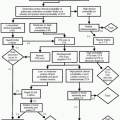Orbital Fractures
George P. Kuo
David J. Grelotti
Orbital fractures are a common result of direct blunt trauma to the eye, such as being struck with a fist or baseball. The orbital floor and/or medial wall are most commonly involved. Superior rim and orbital roof fractures occasionally occur, particularly if the adjacent frontal sinus is well developed. Orbital floor fractures result from sudden increased intraorbital pressure caused by the eyeball’s transmission of the force of a blow. The orbit is also involved in a number of other facial fractures including LeFort II and III fractures, nasoethmoidal complex fractures, and zygoma fractures.
Mechanism. The type of orbital fracture is thought to relate to the nature of the injury. Orbital rim fractures generally result from a direct blow to the bony orbit. Orbital wall fractures, on the other hand, are believed to be the result from a sudden increase in intraorbital pressure caused by a blow to the orbit and subsequent transmission of the force to the orbital wall. Fracture fragments are typically directed away from the orbit causing a “blow-out” fracture. However, it is also possible to sustain an orbital wall injury as a result of blunt trauma to the frontal bone or maxilla with subsequent transmission of the force to the orbital roof or floor. With this mechanism, it is not uncommon to find fracture fragments within the orbital space or a “blow-in” fracture.
Vision-threatening injuries can co-occur with orbital fracture. Prompt attention should be paid to individuals experiencing monocular diplopia, loss of vision, severe eye pain, evidence of corneal laceration or hyphema, or a triad of eye pain, proptosis, and central retinal artery pulsations (suggesting orbital hemorrhage). These are ophthalmologic emergencies and require urgent evaluation and possible surgical intervention by an ophthalmologist.
Symptoms and Signs.
With an appropriate history of trauma, an orbital floor fracture is suspected if one or more of the following are present:
Diplopia, the most common symptom, is caused by entrapment or contusion of extraocular muscle(s) near the fracture.
Decreased ocular motility, especially on vertical gaze (classically, a loss of upward gaze).
Enophthalmos occurs especially if the fracture is large, but may be masked if intraorbital edema and/or hemorrhage is present, which can even cause initial proptosis (exophthalmos).
Hypoesthesia (hypesthesia) of the ipsilateral cheek is a particularly reliable sign and is caused by concomitant injury to the infraorbital nerve, which travels in a groove and canal in the orbital floor.
Differential Diagnosis
primarily includes orbital edema and/or hematoma without a fracture. These can cause any of the first three clinical findings listed in the preceding text.
Entrapment is a clinical diagnosis in which there is severe restriction of eye movement, often causing diplopia, due to “catching” of the orbital contents by edges of the fracture. Certain computed tomographic (CT) findings support the diagnosis of entrapment, but CT cannot rule in or out the entrapment (see subsequent text).




Stay updated, free articles. Join our Telegram channel

Full access? Get Clinical Tree



